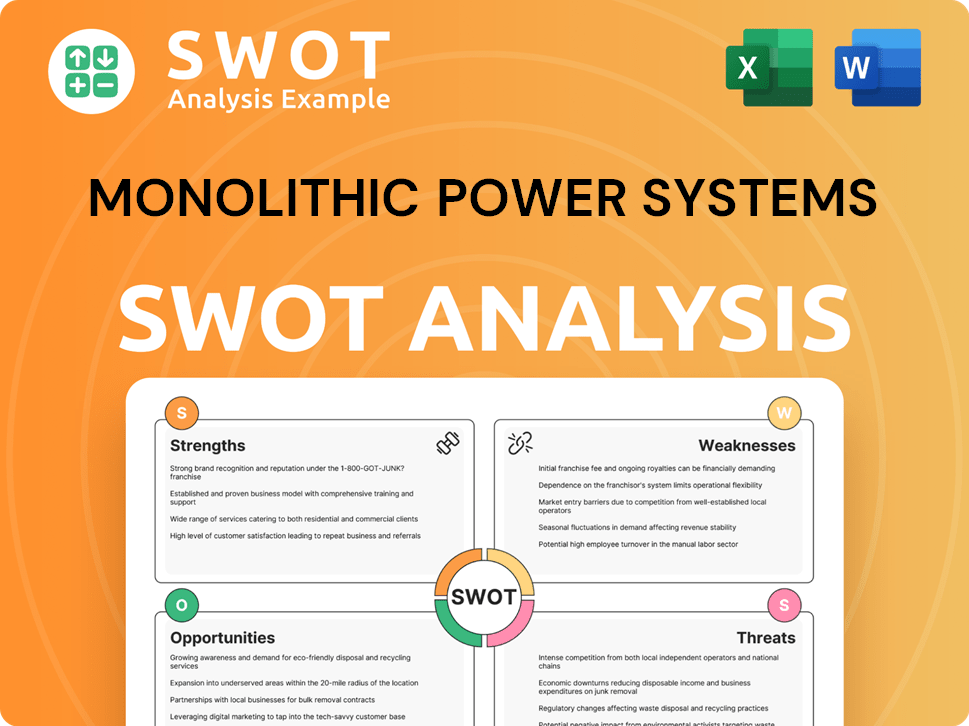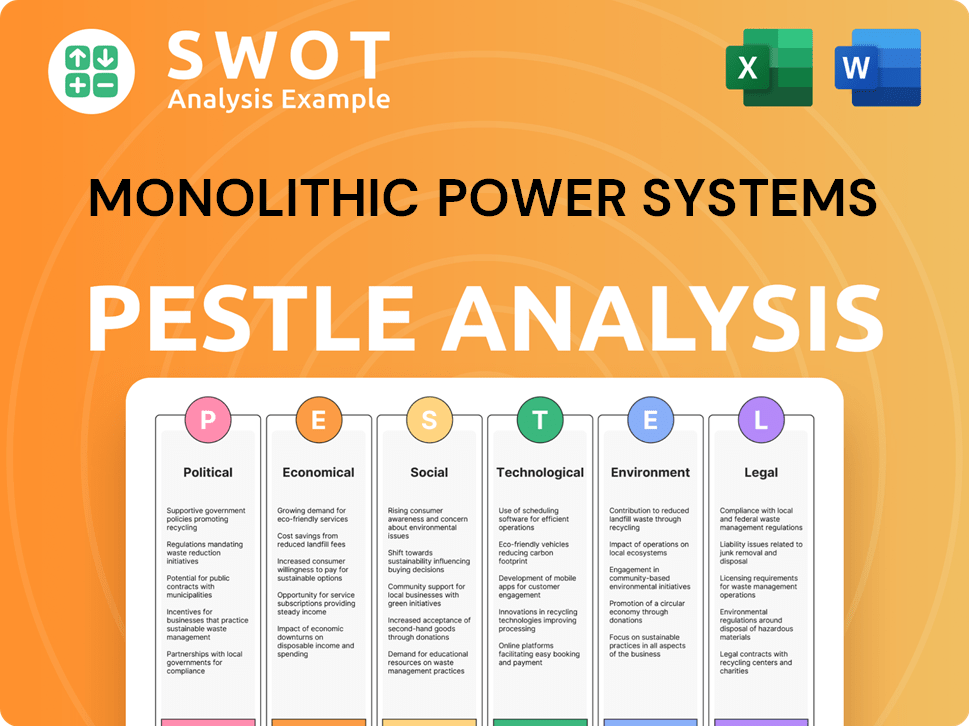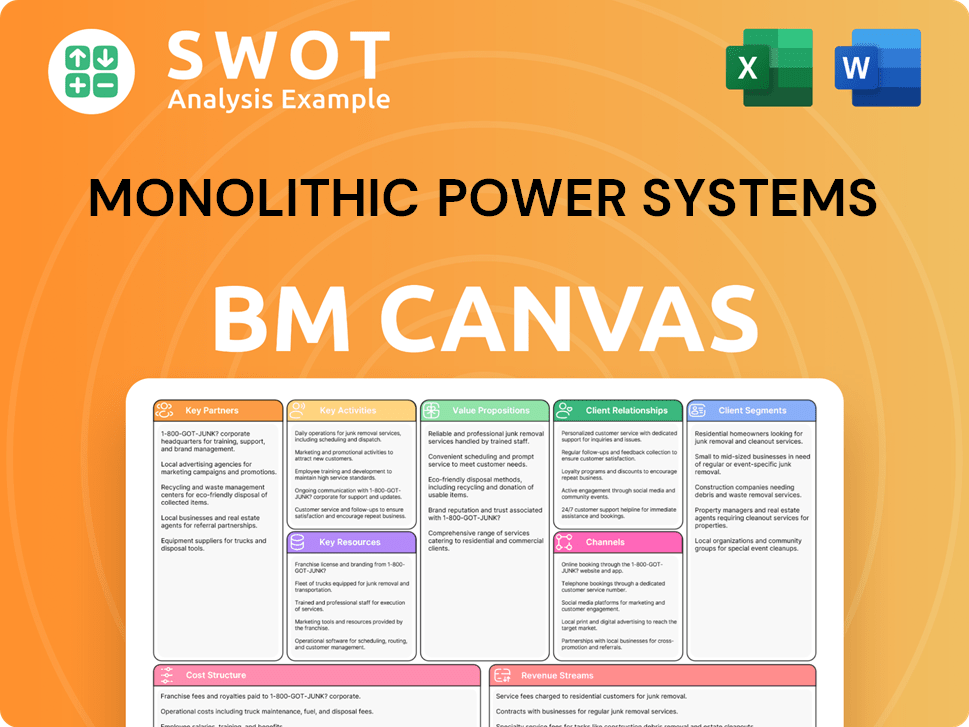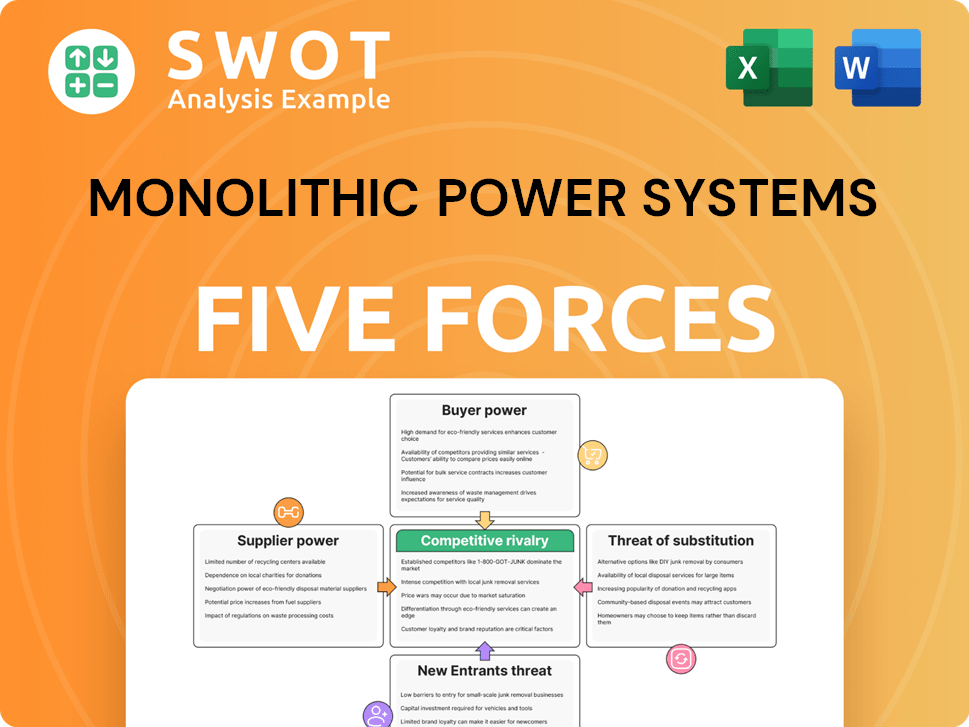Monolithic Power Systems Bundle
Who are Monolithic Power Systems' Key Customers?
Monolithic Power Systems (MPS) is a leading provider of power management solutions, but who exactly are they serving? Understanding the customer demographics and target market analysis is crucial for grasping MPS's strategic direction and future growth. This analysis dives deep into the customer profile of MPS, revealing the industries and applications driving its success.

Founded in 1997, MPS has evolved significantly, adapting to dynamic market shifts like the AI boom. The Monolithic Power Systems SWOT Analysis provides further insights into their strategic positioning. This exploration of MPS's customer base will highlight their market segmentation, customer acquisition strategy, and the key trends shaping their business, offering a comprehensive view of this innovative company's target audience and its impact on the power management ICs market.
Who Are Monolithic Power Systems’s Main Customers?
Understanding the customer demographics and target market is crucial for any company's success. For Monolithic Power Systems, a deep dive into their customer base reveals a strategic focus on business-to-business (B2B) relationships. Their primary customer segments are key players in the electronics industry.
The company's target market analysis highlights Original Equipment Manufacturers (OEMs), Original Design Manufacturers (ODMs), and Electronic Manufacturing Service (EMS) providers. These entities integrate MPS's power management solutions into their products, making them the core of MPS's customer profile. This B2B model shapes MPS's market segmentation and customer acquisition strategy.
MPS's success is closely tied to the performance of these key customer segments. By focusing on these areas, MPS can tailor its product offerings and sales strategies to meet the specific needs of its target audience, driving growth and market share.
The Enterprise Data segment, including AI and server applications, is MPS's largest and fastest-growing segment. In 2024, revenue surged by 121.7% to $716.2 million, accounting for 32.5% of total revenue. This growth is driven by the increasing demand for power management solutions in data centers and AI infrastructure.
This segment represented 22.7% of total revenue in 2024, with $501.6 million. It encompasses components for computers, notebooks, and storage networks. In Q1 2025, this segment saw a significant 38% quarter-over-quarter increase due to strong demand for memory and notebook solutions.
Contributing 18.8% of total revenue in 2024 with $414.0 million, this segment is driven by advanced driver assistance systems (ADAS), infotainment applications, and battery management systems. In Q1 2025, automotive revenue increased by 66% year-over-year.
This segment accounted for 10.2% of 2024 revenue, totaling $225.9 million, primarily from power solutions for optical modules, routers, and wireless applications.
This segment's revenue was $202.0 million in 2024, representing 9.1% of total revenue. It includes components for smart TVs, home appliances, and gaming solutions.
This segment contributed 6.7% of total revenue in 2024, with $147.4 million, serving applications like power generators, security systems, and smart meters.
MPS's customer demographics show a clear focus on B2B relationships, with OEMs, ODMs, and EMS providers as primary customers. The company's market segmentation strategy is driven by these key customer groups and their specific needs.
- Enterprise Data is the fastest-growing segment, driven by AI and server applications.
- Automotive and Storage & Computing segments are also significant contributors to revenue.
- MPS's strategic investments and acquisitions, like XSign, reflect its commitment to expanding its product offerings and target markets.
- The company's revenue distribution across various segments indicates a diversified customer base.
- Understanding the customer profile is crucial for MPS's continued success.
Monolithic Power Systems SWOT Analysis
- Complete SWOT Breakdown
- Fully Customizable
- Editable in Excel & Word
- Professional Formatting
- Investor-Ready Format

What Do Monolithic Power Systems’s Customers Want?
Understanding the customer needs and preferences is crucial for any company. For Monolithic Power Systems, this involves a deep dive into the requirements of its business-to-business (B2B) clients, primarily within the technology and industrial sectors. A thorough target market analysis reveals that these customers are driven by a need for superior power management solutions.
The customer demographics of Monolithic Power Systems are primarily composed of entities that demand high-performance, energy-efficient, and reliable components. These needs shape their purchasing decisions and preferences, influencing the company's product development and market strategies. The focus on these factors ensures that MPS remains competitive and aligned with its customers' evolving demands.
The purchasing behaviors of MPS customers are significantly influenced by several key factors that drive their decisions. These elements are critical in understanding the customer profile and tailoring solutions to meet specific needs effectively. MPS's ability to address these key areas directly impacts its success.
MPS customers have specific needs that drive their purchasing decisions. These include efficiency, reliability, and cost-effectiveness. MPS's ability to meet these needs directly impacts its market position and customer satisfaction. These factors are essential for MPS to maintain its competitive edge and customer loyalty.
- Efficiency and Performance: Customers seek energy-efficient solutions. MPS's power management solutions are designed to improve efficiency, leading to reduced energy consumption and smaller form factors. For example, in 2024, the demand for energy-efficient components in data centers increased by approximately 15%, reflecting the growing need for reduced operational costs and environmental sustainability.
- Reliability and Quality: High-quality components are essential, especially in demanding applications like automotive and enterprise data centers. MPS emphasizes providing robust solutions with industry-leading quality. In the automotive sector, the demand for reliable power management ICs (PMICs) is expected to grow by 10% annually through 2025, driven by the increasing complexity of vehicle electronics.
- Integration and Compactness: Customers prefer solutions that integrate multiple functions onto a single chip, saving space and simplifying design. This is a key advantage highlighted by MPS, as it allows for more compact and efficient designs. Market research indicates that the demand for integrated power management solutions is increasing by about 8% per year in the industrial automation sector.
- Cost-Effectiveness: While performance is crucial, customers also seek cost-effective solutions. MPS aims to deliver solutions that are both energy-efficient and cost-effective. The balance between performance and cost is a critical factor in customer decision-making.
- Technical Support and Resources: Given the complexity of integrated circuits, customers value strong technical support. MPS provides extensive support, including design assistance, training, and documentation. This addresses potential pain points in product selection and utilization. The availability of comprehensive technical support can improve customer satisfaction by up to 20%.
- Adaptability and Innovation: The rapidly evolving technology landscape means customers need partners who can innovate and adapt. MPS invests in new technologies and expands into new markets. For example, MPS is expanding its presence in the robotics and building automation sectors, which are projected to grow by 12% and 9% respectively in 2024.
For more insights into how MPS generates revenue, you can explore the Revenue Streams & Business Model of Monolithic Power Systems.
Monolithic Power Systems PESTLE Analysis
- Covers All 6 PESTLE Categories
- No Research Needed – Save Hours of Work
- Built by Experts, Trusted by Consultants
- Instant Download, Ready to Use
- 100% Editable, Fully Customizable

Where does Monolithic Power Systems operate?
The geographical market presence of Monolithic Power Systems (MPS) is heavily concentrated in Asia, reflecting a strategic focus on this region. In 2024, the company generated a significant portion of its revenue from Asian markets. This strategic emphasis is a key element of their overall business strategy.
Understanding the geographic distribution of MPS's revenue is crucial for a comprehensive target market analysis. This distribution highlights the importance of the Asian market and provides insights into the company's growth drivers and potential areas for expansion. Analyzing these demographics helps in understanding the customer profile for MPS products.
MPS's approach includes localizing its offerings and supply chain, particularly with a 'China for China' strategy. This involves manufacturing chips for Chinese customers within China, while chips for non-Chinese customers are produced outside China. The company also aims to expand its presence beyond Asia to boost long-term growth, as highlighted in a recent article about Monolithic Power Systems.
China is MPS's largest market. It accounted for 53.39% of total revenue in the twelve months ended 2024. China's revenue grew by 26.06% in 2024. In Q1 2025, China represented 51.3% of net sales.
Taiwan is a significant revenue contributor, accounting for 26.19% of total revenue in the twelve months ended 2024. Taiwan saw the strongest growth at 87.95% in 2024. In Q1 2025, Taiwan represented 16.9% of net sales.
South Korea contributed 7.61% of total revenue in the twelve months ended 2024, and 9.3% of net sales in Q1 2025. This market is a consistent contributor to MPS's revenue.
South East Asia accounted for 3.57% of total revenue in the twelve months ended 2024. This region represents a growing market for MPS.
Europe represented 3.94% of total revenue in the twelve months ended 2024. Europe's revenue decreased by 15.7% year-over-year in Q3 2024.
Japan contributed 2.8% of total revenue in the twelve months ended 2024. This market is a stable contributor to MPS's revenue.
The U.S. market accounted for 2.5% of total revenue in the twelve months ended 2024 and 5.3% of net sales in Q1 2025. This market is a key area for future expansion.
MPS is expanding beyond Asia to boost long-term growth. This includes strategic investments in new technologies like silicon carbide. Initial revenue from silicon carbide is expected to ramp up in late 2025, with further applications planned for 2025 and 2026. This expansion is part of MPS's broader market segmentation strategy.
- Focus on 'China for China' strategy.
- Expansion into new technologies like silicon carbide.
- Geographic diversification beyond Asia.
Monolithic Power Systems Business Model Canvas
- Complete 9-Block Business Model Canvas
- Effortlessly Communicate Your Business Strategy
- Investor-Ready BMC Format
- 100% Editable and Customizable
- Clear and Structured Layout

How Does Monolithic Power Systems Win & Keep Customers?
The strategies employed by Monolithic Power Systems (MPS) for customer acquisition and retention are multifaceted, focusing on technical innovation, strategic partnerships, and comprehensive customer support. MPS targets the B2B market, particularly OEMs, ODMs, and EMS providers, with a focus on delivering high-performance power management solutions. Their approach is designed to build long-term relationships and ensure sustained growth in a competitive market.
MPS leverages a combination of direct sales, third-party distributors, and value-added resellers to reach a broad customer base. This diversified approach allows them to effectively penetrate various market segments. Furthermore, their commitment to continuous innovation and product diversification, including strategic acquisitions, plays a crucial role in attracting and retaining customers by addressing evolving market needs.
The company's success is also driven by its focus on high-growth sectors and its commitment to providing extensive technical support and training. These strategies are crucial for ensuring customer satisfaction and driving repeat business. For a deeper understanding of the company's evolution, consider reading Brief History of Monolithic Power Systems.
MPS utilizes a multi-channel approach to reach its target market. This includes direct sales teams, third-party distributors, and value-added resellers. Agreements with major distributors grant non-exclusive rights to promote and sell MPS products, facilitating market development and expanding their customer reach.
MPS continuously innovates in power management solutions, focusing on energy efficiency, compact designs, and reliability. This includes expanding their product portfolio into new markets and addressing emerging trends. Strategic acquisitions, such as XSign, further enhance their offerings and attract customers seeking advanced solutions.
MPS strategically targets high-growth sectors, such as enterprise data and automotive. Their strong performance in these segments, with Enterprise Data revenue growing by 121.7% in 2024, demonstrates successful market penetration and customer acquisition. This focus allows them to capitalize on the increasing demand for advanced power solutions.
MPS provides extensive technical support and consultation to help customers optimize product selection. They offer training sessions, webinars, and technical documentation to ensure effective product utilization. This commitment to customer support fosters long-term relationships and enhances customer retention rates.
MPS actively pursues 'design wins' with key customers, securing their products in future designs of major OEMs. Strong revenue in Q3 2024 was attributed to design wins in client compute and communications. Revenue ramps are expected in the second half of 2025 due to ongoing design wins.
To ensure supply stability and adapt to market changes, MPS maintains a diversified supply chain. This includes local manufacturing for certain regions, such as the 'China for China' strategy. This approach mitigates risks and ensures consistent product availability, which is vital for customer retention.
Monolithic Power Systems Porter's Five Forces Analysis
- Covers All 5 Competitive Forces in Detail
- Structured for Consultants, Students, and Founders
- 100% Editable in Microsoft Word & Excel
- Instant Digital Download – Use Immediately
- Compatible with Mac & PC – Fully Unlocked

Related Blogs
- What are Mission Vision & Core Values of Monolithic Power Systems Company?
- What is Competitive Landscape of Monolithic Power Systems Company?
- What is Growth Strategy and Future Prospects of Monolithic Power Systems Company?
- How Does Monolithic Power Systems Company Work?
- What is Sales and Marketing Strategy of Monolithic Power Systems Company?
- What is Brief History of Monolithic Power Systems Company?
- Who Owns Monolithic Power Systems Company?
Disclaimer
All information, articles, and product details provided on this website are for general informational and educational purposes only. We do not claim any ownership over, nor do we intend to infringe upon, any trademarks, copyrights, logos, brand names, or other intellectual property mentioned or depicted on this site. Such intellectual property remains the property of its respective owners, and any references here are made solely for identification or informational purposes, without implying any affiliation, endorsement, or partnership.
We make no representations or warranties, express or implied, regarding the accuracy, completeness, or suitability of any content or products presented. Nothing on this website should be construed as legal, tax, investment, financial, medical, or other professional advice. In addition, no part of this site—including articles or product references—constitutes a solicitation, recommendation, endorsement, advertisement, or offer to buy or sell any securities, franchises, or other financial instruments, particularly in jurisdictions where such activity would be unlawful.
All content is of a general nature and may not address the specific circumstances of any individual or entity. It is not a substitute for professional advice or services. Any actions you take based on the information provided here are strictly at your own risk. You accept full responsibility for any decisions or outcomes arising from your use of this website and agree to release us from any liability in connection with your use of, or reliance upon, the content or products found herein.